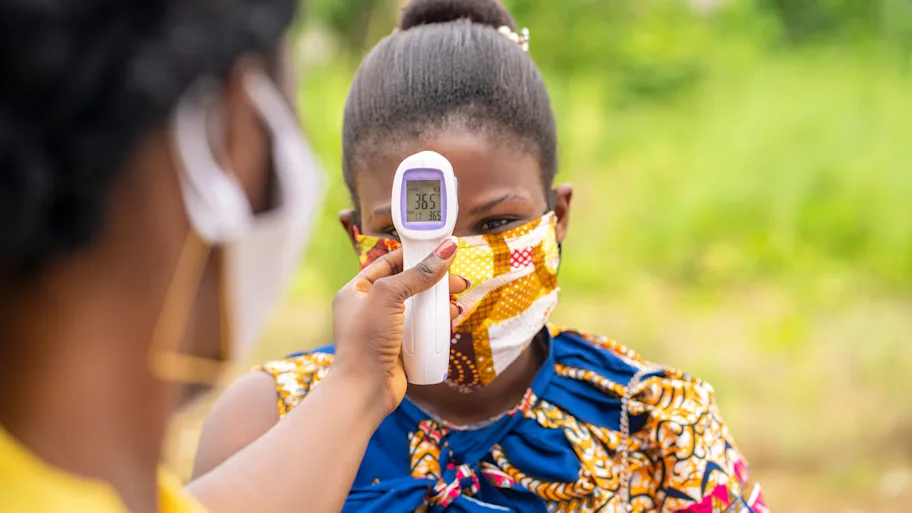
- Science news
- Featured news
- 10 Frontiers articles that caught the world’s attention in 2023
10 Frontiers articles that caught the world’s attention in 2023

As part of Frontiers’ passion to make science available to all, we highlight just a small selection of the most fascinating research published with us each month to inspire current and future researchers to achieve greatness.
2023 was no different, and saw many game-changing discoveries contribute to the world’s breadth of knowledge on topics ranging from the climate crisis to artificial intelligence, and exercise to fishing Neanderthals. So to round off the year, here are 10 Frontiers articles from the past year that got the world’s leading media talking.
1. Antarctic extreme events: ‘All-time records are being shattered not from decades ago, but from the last few years and months’
42 governments around the world have agreed to protect Antarctica’s environment. While the main focus has been on operational activities in Antarctica, global warming caused by fossil-fuel burning by these (and other) countries has left Antarctica on the brink of irreversible change.
A study published in Frontiers in Environmental Science in August this year revealed that, in addition to the influence of gradual global heating, Antarctica is increasingly affected by extreme environmental events; a recognized and predicted outcome of our heating world.
Writing as part of Frontiers’ guest editorials series, Prof Martin Siegert – deputy vice chancellor of the University of Exeter (Cornwall) – discussed how without a rapid shift to net-zero greenhouse gas emissions by 2050, the Antarctic environment will experience ever more drastic changes.
Read article: https://www.frontiersin.org/articles/10.3389/fenvs.2023.1229283/full
2. ‘Golden boy’ mummy was protected by 49 precious amulets, CT scans reveal
The ancient Egyptians believed that when we died, our spiritual body sought out an afterlife similar to this world. But entry into this afterlife wasn’t guaranteed: it first required a perilous journey through the underworld, followed by an individual last judgment. For this reason, relatives and embalmers did everything they could to ensure that their loved one might reach a happy destination.
Writing in Frontiers in Medicine, scientists from Egypt used computerized tomography (CT) to ‘digitally unwrap’ the intact, never-opened mummy of a 2,300-year-old teenage boy of high socioeconomic status. They found that this ‘golden boy’ is an undisturbed showcase of ancient Egyptian beliefs about life after death and was sent on his way with no fewer than 49 amulets of 21 types to promote his bodily resurrection. These results provided a unique insight into mummification procedures and beliefs about the importance of grave ornaments during the Ptolemaic period.
Read article: https://www.frontiersin.org/articles/10.3389/fmed.2022.1028377/full
3. Scientists unveil plan to create biocomputers powered by human brain cells
AI has long been inspired by the human brain. This approach proved highly successful: AI boasts impressive achievements – from diagnosing medical conditions to composing poetry. Still, the original model continues to outperform machines in many ways. This is why, for example, we can ‘prove our humanity’ with trivial image tests online. What if instead of trying to make AI more brain-like, we went straight to the source?
Scientists across multiple disciplines are working to create revolutionary biocomputers where three-dimensional cultures of brain cells, called brain organoids, serve as biological hardware. They described their roadmap for realizing this vision earlier this year in the journal Frontiers in Science.
“Brains have an amazing capacity to store information, estimated at 2,500TB,” said Prof Thomas Hartung of Johns Hopkins University. “We’re reaching the physical limits of silicon computers because we cannot pack more transistors into a tiny chip. But the brain is wired completely differently. It has about 100 billion neurons linked through more than 1,015 connection points. It’s an enormous power difference compared to our current technology.”
Read article: https://www.frontiersin.org/journals/science/articles/10.3389/fsci.2023.1017235/full
4. Eating almonds daily boosts exercise recovery molecule by 69% among ‘weekend warriors’
For those who exercise regularly, eating almonds each day might be the ideal new year’s resolution. Earlier this year, the findings of a randomized controlled trial were published in Frontiers in Nutrition that showed female and male participants who ate 57g almonds daily for one month had more of the beneficial fat 12,13-dihydroxy-9Z-octadecenoic acid (12,13-DiHOME) in their blood immediately after a session of intense exercise than control participants.
This molecule, a so-called oxylipin (oxidized fat), is synthetized from linoleic acid by brown fat tissue and has a beneficial effect on metabolic health and energy regulation.
Corresponding author Dr David C Nieman, a professor and director of the Appalachian State University Human Performance Laboratory at the North Carolina Research Campus, said: “Here we show that volunteers who consumed 57g of almonds daily for one month before a single ‘weekend warrior’ exercise bout had more beneficial 12,13-DiHOME in their blood immediately after exercising than control volunteers. They also reported feeling less fatigue and tension, better leg-back strength, and decreased muscle damage after exercise than control volunteers.”
Read article: https://www.frontiersin.org/articles/10.3389/fnut.2022.1042719/full
5. Our favorite bittersweet symphonies may help us deal better with physical pain
Research has shown that music might be a drug-free way to lower humans’ pain perception. This decreased sensitivity to pain – also known as hypoalgesia – can occur when pain stimuli are disrupted between their point of input and where they are recognized as pain by the conscious mind. In a recent study, researchers in Canada examined what type of music helps to dampen pain perception.
Writing in Frontiers in Pain Research, they found that participants’ perception of pain intensity and unpleasantness was reduced when they listened to their favorite music compared to pre-selected relaxing music, which is commonly used in clinical settings. In addition, bittersweet music – unlike other emotionally loaded music – was found to further reduce pain unpleasantness.
Read article: https://www.frontiersin.org/articles/10.3389/fpain.2023.1210572/full
6. Proof that Neanderthals ate crabs is another ‘nail in the coffin’ for primitive cave dweller stereotypes
In a cave just south of Lisbon, archeological deposits conceal a Paleolithic dinner menu. As well as stone tools and charcoal, the site of Gruta de Figueira Brava contains rich deposits of shells and bones with much to tell us about the Neanderthals that lived there – especially about their meals. A study published in Frontiers in Environmental Archaeology has shown that 90,000 years ago, these Neanderthals were cooking and eating crabs.
“At the end of the Last Interglacial, Neanderthals regularly harvested large brown crabs,” said Dr Mariana Nabais of the Catalan Institute of Human Paleoecology and Social Evolution (IPHES-CERCA), lead author of the study. “They were taking them in pools of the nearby rocky coast, targeting adult animals with an average carapace width of 16cm. The animals were brought whole to the cave, where they were roasted on coals and then eaten.”
Read article: https://www.frontiersin.org/articles/10.3389/fearc.2023.1097815/full
7. Humans don’t hibernate, but we still need more winter sleep
Whether we’re night owls or morning larks, our body clocks are set by the sun. Theoretically, changing day length and light exposure over the course of the year could affect the duration and quality of our sleep. But figuring out how this applies in practice is difficult. Although studies where people assess their own sleep have suggested an increase in sleep duration during winter, objective measures are needed to determine how exactly the seasons affect sleep.
Scientists studying sleep difficulties have published data in Frontiers in Neuroscience that shows that, even in an urban population experiencing disrupted sleep, humans experience longer REM sleep in winter than summer and less deep sleep in autumn.
Read article: https://www.frontiersin.org/articles/10.3389/fnins.2023.1105233/full
8. The right sports bra may increase your running performance by 7%
Researchers are one step closer to understanding the influence of good running apparel on running performance and injury risk. A study in Frontiers in Sports and Active Living published earlier this year found that greater breast support during running is associated with increased knee joint stiffness, altering the lower body biomechanics of female runners. Specifically, a low support bra was associated with a 2% increase in knee joint stiffness, and a high support bra with 5%. Overall, a well-designed sports bra could increase a female’s running performance by 7%.
The findings showed that breast support not only influences movement of the breasts but that compensations occur across the entire body. These compensations can lead to reduced running performance, increased injury risk, and even the development of chronic pain such as back and chest pain.
Read article: https://www.frontiersin.org/articles/10.3389/fspor.2023.1113952/full
9. People taking adult education classes run lower risk of dementia
It’s well known that regular cognitive activity, for example brainteasers, sudokus, or certain video games in middle and old age tends to protect against cognitive decline and dementias like Alzheimer’s. But many of us regularly engage in adult education classes, for example learning a language or a new skill. Is such adult education likewise associated with a lower risk of cognitive decline and dementia?
Yes, according to researchers from the Institute of Development, Aging and Cancer of Tohoku University in Sendai, Japan, who have shown this for the first time in a study in Frontiers in Aging Neuroscience.
“Here we show that people who take adult education classes have a lower risk of developing dementia five years later,” said Dr Hikaru Takeuchi, an associate professor and the study’s first author. “Adult education is likewise associated with better preservation of nonverbal reasoning with increasing age.”
Read article: https://www.frontiersin.org/articles/10.3389/fnagi.2023.1212623/full
10. Endangered turtle population under threat as pollution may lead to excess of females being born
Green sea turtles are listed as endangered on the IUCN Red List of Threatened Species. They are at risk of extinction due to poaching, collisions with boats, habitat destruction, and accidental capture in fishing gear.
But another threat, linked to climate change, is more insidious: sea turtles have temperature-dependent sex determination, which means that more and more embryos develop into females as temperatures keep rising. Already, in the northern part of the Great Barrier Reef off Australia, hundreds of females are born for every male.
Writing in Frontiers in Marine Science, researchers showed that the resulting risk of extinction due to a lack of male green sea turtles may be compounded by pollution.
Read article: https://www.frontiersin.org/articles/10.3389/fmars.2023.1238837/full






